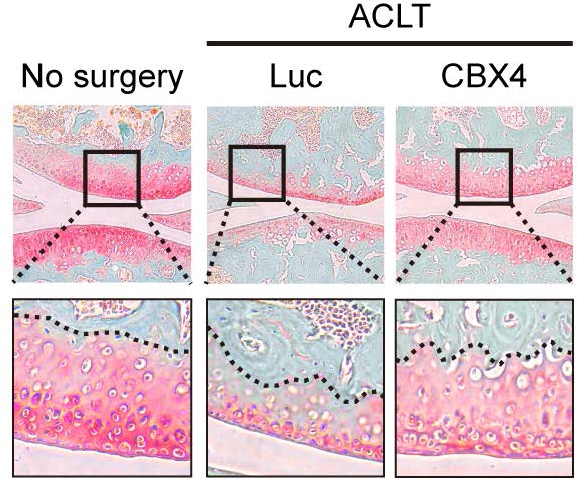Aging is a risk factor for the development of osteoarthritis (OA), a chronic disease characterized by degeneration of articular cartilage leading to pain and physical disability. Senescent mesenchymal stem cells (hMSCs) are found in cartilage tissues isolated from patients suffering from osteoarthritis. Notably, senescent MSCs have been regarded as an important therapeutic target for geroprotection against tissue degeneration.
Recently, in a study published in Cell Reports, scientists found that a protein factor, CBX4, could help to cure osteoarthritis in mice, after four years of work.
These scientists, from the Institute of Zoology of the Chinese Academy of Sciences (CAS), Peking University and the Institute of Biophysics of CAS, found that CBX4 safeguarded hMSCs against cellular senescence through the regulation of nucleolar architecture and function.
Importantly, CBX4 overexpression attenuated the development of osteoarthritis in mice, suggesting a target for therapeutic interventions against aging-associated disorders.
CBX4, a component of polycomb repressive complex 1 (PRC1), plays an important role in the regulation of cell identity and organ development through gene silencing.
CBX4 protein was downregulated in aged hMSCs whereas CBX4 knockout in hMSCs resulted in destabilized nucleolar heterochromatin, enhanced ribosome biogenesis, increased protein translation, and accelerated cellular senescence.
CBX4 maintained nucleolar homeostasis by recruiting nucleolar protein fibrillarin and heterochromatin protein KRAB-associated protein 1 (KAP1) at nucleolar rDNA, limiting the excessive expression of rRNAs.
Importantly, overexpression of CBX4 alleviated physiological hMSC aging and attenuated the development of osteoarthritis in mice.
These findings not only highlight that CBX4-mediated nucleolar homeostasis is a key gatekeeper for hMSC aging. They also open an avenue for preventing aging-associated stem cell exhaustion and, hopefully, treating age-related disorders in the future.
Taken together, the researchers revealed a new mechanism for the nucleolar protein CBX4 in maintaining hMSC homeostasis.
These findings prove the feasibility of using gene therapy strategies to rejuvenate senescent cells and treat osteoarthritis, providing a promising option for future geriatrics and regenerative medicine.


Figure. CBX4 maintains nucleolar homeostasis, alleviates senescence and osteoarthritis.


